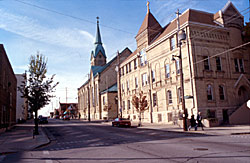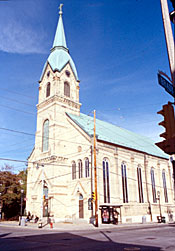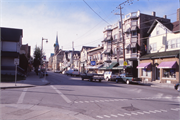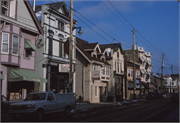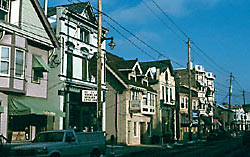East Brady Street Historic District
Milwaukee, Milwaukee County
The earliest Polish ethnic neighborhoods in Milwaukee were established in the post-Civil War period. At this time, large numbers of Polish immigrants entered the city's steel, leatherworking, and other materials processing industries. The majority of Poles who came to Milwaukee were part of the third wave of Polish emigration, which began approximately in 1865 and lasted into the 1920s. These were primarily economic emigrants who left the harsh conditions of their homeland. At first the new arrivals settled on the city¿s south side; however, growing numbers found employment and were able to purchase property in the East Brady Street area. As a result, by the early 1870s East Brady Street began to emerge as a center of Polish commerce with a concentration of working class Polish immigrants living in the surrounding neighborhood. The district reached its peak in the late 1890s as a major commercial strip boasting bakeries, grocers, dry goods stores, livery stables, saloons, and a bowling alley.
The district contains a few early working-class cottages, several blocks of commercial buildings, and the St. Hedwig¿s Catholic church complex at its center. The district is further noted for the original mix of uses and building types found in the streetscape. Most buildings in the district were constructed between 1875 and 1931 and reflect a broad range of architectural styles. The earliest buildings are generally the simplest, with architectural embellishment appearing as the street grew in commercial and cultural importance. With the exception of St. Hedwig's, the buildings of the district reflect the styles popular in Milwaukee during the period, including the Italianate, Queen Anne, Classical Revival, and the German Renaissance Revival. St. Hedwig's Church, designed by local architect Henry Messmer, is a Romanesque-influenced building with decorative elements drawn from Gothic, eighteenth century and eastern European motifs. In particular the copper-clad spire of the central tower recalls the eighteenth and nineteenth century churches of Eastern Europe. St. Hedwig's, like other Polish churches in Milwaukee, is characterized by arched windows and domical towers and spires.
In the 1920s the ethnic focus of the neighborhood began to shift to Italian, reaching its peak in the 1950s. By the 1960s it was a haven for Milwaukee's counterculture youth movement. Today, the street features a collection of specialty shops and restaurants.
|

